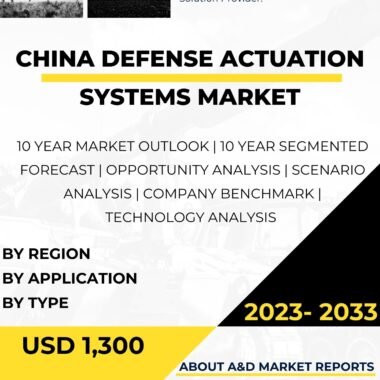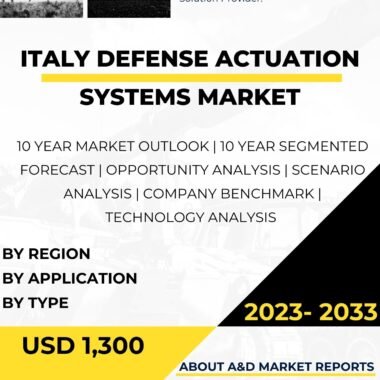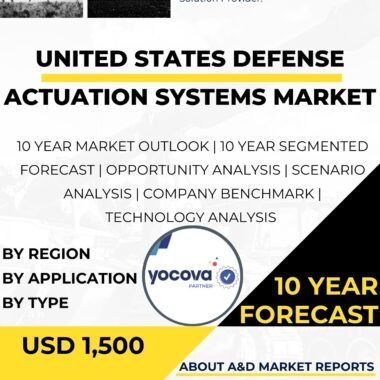Description
The United Kingdom’s defense actuation systems market plays a vital role in the country’s defense industry, providing critical motion control solutions for various military applications. Actuation systems are integral components of military platforms, enabling precise and controlled movement in aircraft, naval vessels, ground vehicles, and weapon systems. As the UK continuously modernizes its defense capabilities, the demand for advanced and reliable actuation systems has been steadily increasing.
Actuation systems serve as the mechanical link between the control inputs and the desired movements of military platforms. These systems convert electrical, hydraulic, or pneumatic signals into motion, allowing precise control over the platform’s flight, navigation, and weapon deployment. In military aircraft, actuation systems are crucial for controlling flight surfaces such as ailerons, elevators, and rudders. In naval vessels, they enable the movement of shipboard systems like stabilizers and steering gear. In ground vehicles, actuation systems are essential for turret rotation, suspension control, and various other functionalities.
Various components and technologies contribute to the effectiveness and reliability of defense actuation systems. Electric motors are commonly used for precise and rapid motion control in aircraft and unmanned aerial vehicles (UAVs). Hydraulic actuators are prevalent in large naval vessels and heavy ground vehicles due to their high power-to-weight ratio. Pneumatic systems find application in certain aircraft systems and ordnance deployment mechanisms.
Advanced materials, such as composites and high-strength alloys, are incorporated into actuator designs to reduce weight while maintaining durability. Moreover, cutting-edge sensors and control systems enhance the performance and responsiveness of actuation systems, ensuring optimal performance in dynamic and challenging operational environments.
One of the main drivers of the UK defense actuation systems market is the country’s commitment to modernizing its defense capabilities. As threats and challenges evolve, the military must equip its assets with state-of-the-art actuation systems to maintain a competitive edge. The rise of unmanned systems and autonomous vehicles in defense applications also drives demand for highly reliable and efficient actuation systems. UAVs, in particular, rely heavily on actuation systems for flight control, surveillance, and payload deployment.
The need for compact and lightweight systems is another driving factor in the defense actuation systems market. As military platforms become more agile and versatile, the demand for smaller and lighter actuation systems increases. Reduced weight contributes to improved fuel efficiency, extended range, and increased payload capacity in aircraft and ground vehicles.
The UK defense industry benefits from collaborations between government agencies, defense contractors, and research institutions. These partnerships foster innovation, encouraging the development of cutting-edge actuation technologies. Research and development efforts focus on enhancing the reliability, efficiency, and adaptability of actuation systems, ensuring they can withstand harsh operating conditions and provide seamless performance.
Furthermore, advancements in materials science and manufacturing processes enable the production of more robust and efficient actuation components. 3D printing, for instance, offers new possibilities for creating complex actuator geometries and optimizing designs for specific military applications.
Export opportunities also contribute to the growth of the UK defense actuation systems market. British defense contractors often collaborate with international partners, providing them with advanced actuation solutions for a wide range of military platforms. Exporting actuation systems not only strengthens the UK’s defense industry but also fosters strategic partnerships with allied nations.
To ensure the integrity and reliability of 3D printed components, establishing standards and qualification processes is crucial. Components manufactured through 3D printing must undergo rigorous testing and validation to meet stringent military and aerospace standards. Collaborative efforts between defense contractors, government agencies, and regulatory bodies are essential to develop comprehensive standards for additive manufacturing in defense applications.
Despite the advantages, 3D printing also presents challenges for the defense sector. One primary concern is the constant need to stay ahead of rapidly evolving threats and technological advancements. Defense contractors must invest in continuous research and development to keep pace with changing requirements and maintain a competitive edge in the global market.
In conclusion, the United Kingdom’s defense actuation systems market is witnessing continuous growth, driven by the country’s commitment to modernizing its defense capabilities, increasing demand for advanced actuation solutions in unmanned systems, and the need for compact and lightweight systems. Collaborative research and development efforts, along with advancements in materials and manufacturing processes, are propelling the market forward. As the defense industry continues to evolve, actuation systems will remain a critical component, enabling the precise and reliable movement of military platforms and contributing to the country’s national security and defense preparedness.




